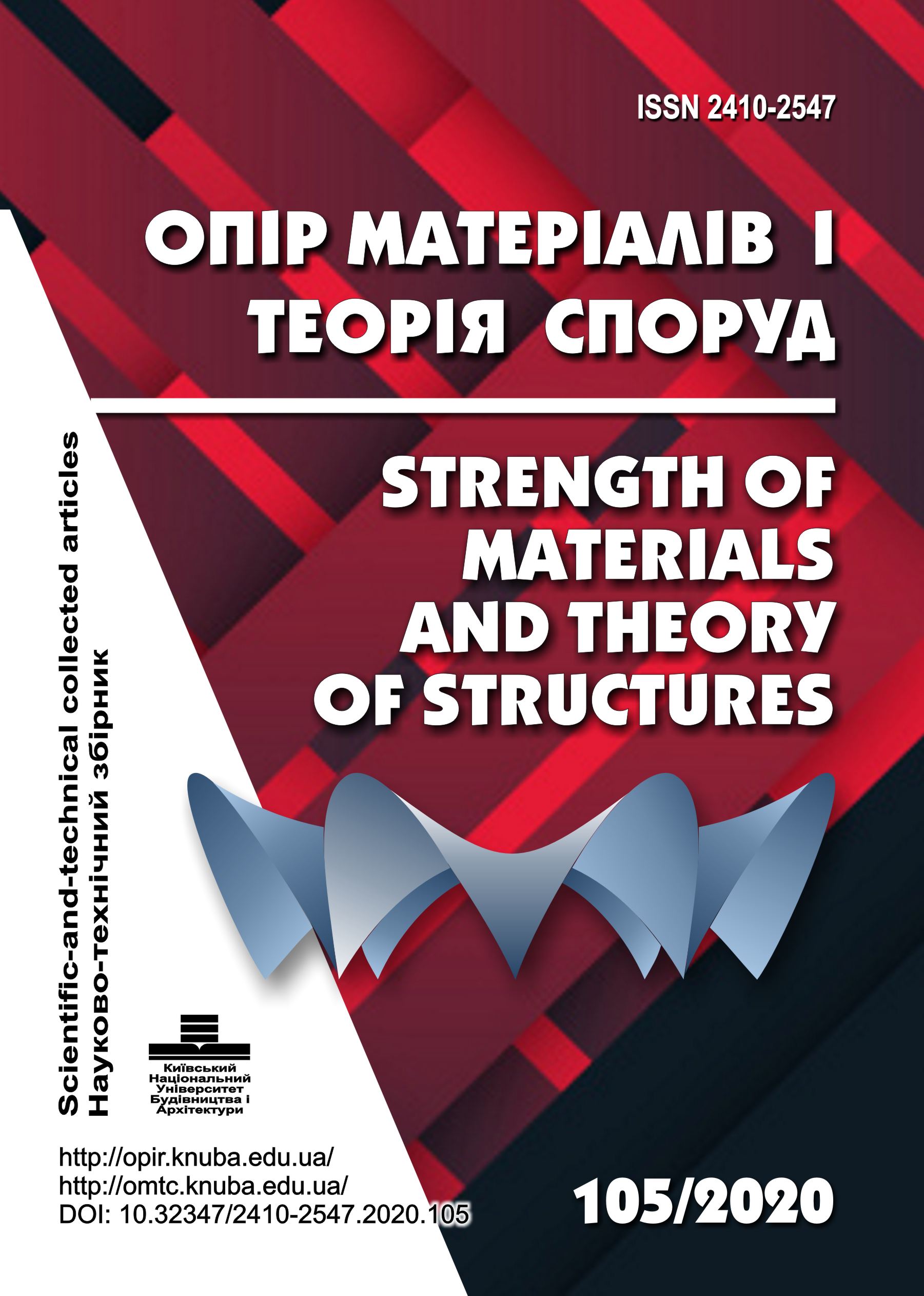Parametric optimization of steel structures based on gradient projection method
DOI:
https://doi.org/10.32347/2410-2547.2020.105.192-220Keywords:
parametric optimization, steel structures, nonlinear programming, buckling constraints, pre-stressing forces, node coordinates, gradient projection method, finite element analysis, numerical algorithmAbstract
The main research goal is the development of a numerical methodology for solving parametric optimization problems of steel structures with orientation on software implementation in a computer-aided design system. The paper has proposed a new mathematical model for parametric optimization problems of steel structures. The design variable vector includes geometrical parameters of the structure (node coordinates), cross-sectional dimensions of the structural members, as well as initial pre-stressing forces introduced into the specified redundant members of the structure. The system of constraints covers load-carrying capacities constraints formulated for all design sections of structural members of the steel structure subjected to all ultimate load case combinations. The displacements constraints formulated for the specified nodes of the steel structure subjected to all serviceability load case combinations have been also included into the system of constraints. The method of the objective function gradient projection onto the active constraints surface with simultaneous correction of the constraints violations has been used for solving the parametric optimization problem. A numerical algorithm for solving the formulated parametric optimization problems of steel structures has been developed in the paper. The comparison of the optimization results of truss structures presented by the paper confirms the validity of the optimum solutions obtained using the proposed numerical methodology.
References
Czarnecki S. Optimal structural design using a genetic algorithm // Theoretical Foundations of Civil Engineering. – 1999. – VII. – p. 201–210.
Czarnecki S. Multithreaded genetic program in truss shape optimization // Theoretical Foundations of Civil Engineering. – 2000. – VIII. – p. 556–560.
Crowder N. P., Denbo R. S., Mulvey J. M. Reporting computational experiments in mathematical programming // Mathematical Programming. – Vol. 15, 1978. – p. 316–329.
DBN V.2.6-198:2014. Steel structures. Design codes. – Kyiv: Minregion of Ukraine, 2014. – 199 p. (ukr)
Guljaev V. I., Bazhenov V. A., Koshkin V. L. Optimization techniques in structural mechanics (Optimization methods in structural mechanic). – Kyiv, 1988. – 192 p. (rus)
Haug E. J., Arora J. S. Applied optimal design: mechanical and structural systems. – John Wiley & Sons, 1979. – 520 p.
Huebner K. H., Dewhirst D. L., Smith D. E., Byrom T. G. The finite element method for engineers (4th ed.) – John Wiley & Sons, Inc. 2001. – 744 p.
I-Cheng Y. Hybrid genetic algorithms for optimization of truss structures // Computer-aided civil and infrastructure engineering. – 1999. – No. 14. – p. 199–206.
Koshkin V. L., Serpak I. O. Optimal design of flexible rod structural members // Strength of materials. – 1993. – No. 25. – p. 834–840. DOI: 10.1007/BF00780267
Kuci E., Henrotte F., Duysinx P., Geuzaine C. Design sensitivity analysis for shape optimization based on the Lie derivative // Computer methods in applied mechanics and engineering. – Vol. 317, 2017. – p. 702–722. DOI: 10.1016/j.cma.2016.12.036
Peleshko I., Yurchenko V. An optimum structural computer-aided design using update gradient method // Proceedings of the 8th International Conference “Modern Building Materials, Structures and Techniques”. – Faculty of Civil Engineering, Vilnius Gediminas Technical University, 2004. – p. 860 – 865.
Peleshko I., Yurchenko V. An improved gradient-based method to solve parametric optimisation problems of the bar structures // Strength of Materials and Theory of Structures: Scientific-and-technical collected articles. – Kyiv: KNUBA, 2020. – Issue 104. (accepted to publication)
Permyakov V. O., Yurchenko V. V., Peleshko I. D. An optimum structural computer-aided design using hybrid genetic algorithm // Proceeding of the International Conference “Progress in Steel, Composite and Aluminium Structures”. – Taylor & Francis Group, London, 2006. – p. 819–826.
Perelmuter A., Yurchenko V. Parametric optimization of steel shell towers of high-power wind turbines // Procedia Engineering. – No. 57, 2013. – p. 895 – 905. DOI: 10.1016/ j.proeng.2013.04.114.
Reklaitis G. V., Ravindran A., Ragsdell K. M. Engineering optimization. Methods and applications. – Wiley, 2006. – 688 p.
Yurchenko V., Peleshko I., Beliaev N. Parametric optimization of steel truss with hollow structural members based on update gradient method // Proceedings of International Conference “Design, Fabrication and Economy of Metal Structures”. – Springer Berlin Heidelberg, 2013. – p. 103–109. DOI: 10.1007/978-3-642-36691-8_16
Wilkinson J. H., Reinsch C. Handbook for Automatic Computation. Volume II: Linear Algebra. – Heidelberg New York Springer-Verlag Berlin, 1971. – 441 p. DOI: 10.1137/1014116.
Downloads
Published
Issue
Section
License
Copyright (c) 2020 Vitalina Yurchenko, Ivan Peleshko

This work is licensed under a Creative Commons Attribution 4.0 International License.
Authors retain copyright and grant the journal right of first publication with the work simultaneously licensed under a Creative Commons Attribution License that allows others to share the work with an acknowledgement of the work's authorship and initial publication in this journal.

